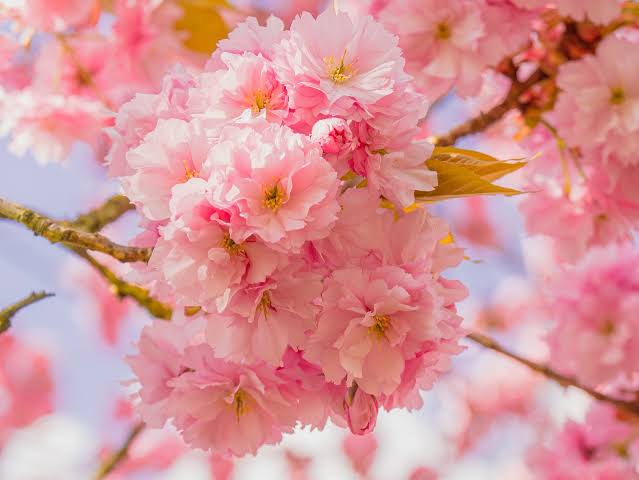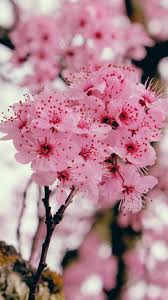Sakura flowers, also known as cherry blossoms, are renowned for their ethereal beauty and cultural significance. These delicate flowers hold a special place in the hearts of people worldwide, particularly in Japan, where they are deeply ingrained in the country’s history, art, and traditions.
When the Sakura flowers bloom, it is a breathtaking sight to behold. The branches of cherry trees become adorned with clusters of vibrant pink or pure white petals, creating a mesmerizing canopy of blossoms. The arrival of Sakura marks the arrival of spring, bringing with it a sense of renewal, hope, and fleeting beauty.
The Sakura flower holds profound symbolism in Japanese culture. Its short-lived blooming period, lasting only a few weeks, serves as a poignant reminder of the transient nature of life. This concept, known as “mono no aware,” reflects an appreciation for the impermanence and the beauty found in fleeting moments. The Sakura’s ephemeral nature encourages people to cherish the present and embrace the ever-changing cycles of life.
In Japan, the Sakura flower holds a revered place in the annual tradition of hanami, which translates to “flower viewing.” During this time, friends, families, and colleagues gather beneath the blooming cherry trees, spreading picnic blankets and indulging in food and drink. The atmosphere is filled with joy, laughter, and a deep appreciation for the delicate blossoms. Hanami is a cherished custom that brings people together and fosters a sense of unity and harmony with nature.
Beyond its cultural significance, Sakura has captured the imagination of artists, poets, and writers throughout history. Its delicate beauty has been immortalized in countless works of art, literature, and even modern media. The allure of Sakura has transcended borders, becoming a symbol of beauty, grace, and the cyclical nature of life itself.
In recent years, the enchantment of Sakura has spread beyond Japan, with cherry blossom festivals being celebrated in various parts of the world. These festivals showcase the Sakura’s mesmerizing blooms and offer an opportunity for people of diverse cultures to come together and appreciate the beauty of nature.
The Sakura flower serves as a powerful reminder of the interconnectedness of all things and the need to appreciate the fleeting moments that make life truly special. Its delicate petals remind us to find beauty even in the briefest of encounters and to embrace the ever-changing nature of our world.
So, next time you witness the Sakura flowers in full bloom, take a moment to pause, admire their splendor, and reflect upon the profound lessons they impart. Let the Sakura inspire you to appreciate the beauty that surrounds you and to live each moment with gratitude and awareness.
Read Also: Significance And Uses of Night Blooming Flowers
History And Significance of Sakura Flowers

The history and significance of Sakura flowers, also known as cherry blossoms, are deeply rooted in Japanese culture and have captivated people for centuries. The story of Sakura unfolds through its historical origins, cultural symbolism, and enduring impact on various aspects of Japanese society.
Historically, the appreciation of cherry blossoms can be traced back to ancient Japan. The cultivation and admiration of cherry trees began during the Nara period (710-794), when Japanese emperors would hold hanami parties beneath blooming cherry trees. These gatherings celebrated the arrival of spring and marked the beginning of rice-planting season.
Over time, cherry blossoms gained popularity among the aristocracy and samurai class during the Heian period (794-1185). They were depicted in literature, poetry, and artwork, symbolizing the transient nature of life and the beauty found in its fleeting moments. The famous anthology “The Tale of Genji,” written by Murasaki Shikibu in the 11th century, contains numerous references to cherry blossoms, further cementing their cultural significance.
During the Edo period (1603-1868), the appreciation of cherry blossoms reached its peak. The ruling shogunate embraced hanami as a way to unify the country and foster a sense of community. Cherry blossom parties became grand events, attracting people from all walks of life. The aesthetic influence of cherry blossoms extended beyond traditional arts and influenced architecture, kimono patterns, and even the design of everyday objects.
The symbolism of Sakura flowers holds great significance in Japanese culture. The transient nature of cherry blossoms represents the beauty and fragility of life, reminding people to cherish the present moment. Sakura embodies the concept of “mono no aware,” an appreciation for the impermanence and ephemeral nature of all things. It serves as a powerful reminder of the cyclical nature of life, where each season brings its own beauty and transformation.
Sakura’s significance also extends to notions of renewal and hope. The blossoming of cherry trees after the cold winter months represents a new beginning and the promise of a fruitful year ahead. In Japan, schools and businesses often begin their fiscal year in April, coinciding with the blooming of cherry blossoms, symbolizing fresh starts and opportunities.
The Sakura’s cultural impact is reflected in various traditions and customs. Hanami, the act of enjoying cherry blossoms, remains a beloved practice in Japan. People gather with friends, family, and colleagues under cherry trees, indulging in food, drink, and lively conversation. The experience fosters a sense of unity, harmony, and appreciation for nature’s beauty.
Cherry blossom festivals, known as “sakura matsuri,” are held across Japan and in many parts of the world. These festivals attract tourists and locals alike, featuring concerts, performances, and illuminated night views of the blooming trees. The festivals celebrate the arrival of spring and showcase the profound impact of Sakura on art, culture, and communal experiences.
Additionally, the history and significance of Sakura flowers are deeply intertwined with Japanese culture. From their ancient roots to their enduring symbolism, cherry blossoms have captivated hearts and inspired people to embrace the transient beauty of life. Sakura’s timeless allure continues to bring joy, unity, and a sense of renewal to people around the world.
Read Also: Economic Importance, Uses, and By-Products of Oil Palm Inflorescence
Complete Growing Guide For Sakura Flowers

Growing Sakura flowers, or cherry blossoms, requires specific conditions and care to ensure their successful growth. Here are some general guidelines to help you grow Sakura flowers.
1. Climate and Location: Sakura trees thrive in temperate regions with distinct seasons. They require a period of cold dormancy during winter followed by a warm spring to induce blooming. Ensure your location has suitable temperature conditions for cherry blossoms to grow.
2. Choose the Right Variety: Select a suitable variety of Sakura tree for your climate and available space. Some popular species include Yoshino cherry (Prunus x yedoensis), Kwanzan cherry (Prunus serrulata ‘Kanzan’), and Weeping cherry (Prunus subhirtella).
3. Soil Preparation: Sakura trees prefer well-draining soil with a slightly acidic pH. Conduct a soil test to check the pH level, and if necessary, amend the soil with organic matter or sulfur to lower the pH. Good drainage is crucial to prevent root rot.
4. Planting: Spring or fall is the ideal time for planting Sakura trees. Dig a hole that is wider and slightly shallower than the root ball. Gently loosen the roots before placing the tree in the hole. Backfill with soil, ensuring the tree is planted at the same depth as it was in the container or nursery. Water thoroughly after planting.
5. Watering: Sakura trees require regular watering, especially during dry periods. Keep the soil consistently moist but not waterlogged. Water deeply, allowing the water to penetrate the root zone. Mulching around the base of the tree can help retain moisture and suppress weed growth.
6. Sunlight: Sakura trees prefer full sun exposure for optimal growth and blooming. Ensure they receive at least six to eight hours of direct sunlight daily.
7. Pruning: Prune Sakura trees during the dormant season to maintain their shape and remove any damaged or diseased branches. Avoid heavy pruning that can interfere with flowering.
8. Fertilization: Apply a balanced, slow-release fertilizer specifically formulated for flowering trees in early spring. Follow the package instructions for proper application rates. Avoid over-fertilizing, as it can promote excessive foliage growth at the expense of blooming.
9. Protection from Pests and Diseases: Monitor your Sakura tree for common pests such as aphids, caterpillars, and scale insects. Treat infestations promptly using appropriate organic or chemical insecticides. Additionally, be vigilant for diseases like fungal infections or bacterial cankers and take necessary measures to prevent or treat them.
10. Patience and Appreciation: Growing Sakura trees requires patience, as it may take several years for them to reach maturity and produce abundant blossoms. Enjoy the process and appreciate the beauty of the tree at each stage of its growth.
Remember that Sakura trees may require specific care based on the variety and your local climate conditions. It’s advisable to consult with local gardening experts or arborists to get specific guidance tailored to your region.
Uses of Sakura Flowers
Sakura flowers, or cherry blossoms, have various uses beyond their aesthetic appeal. Here are some notable uses and applications of Sakura flowers.
1. Cultural Celebrations: Sakura flowers hold immense cultural significance, particularly in Japan. They are celebrated during hanami festivals, where people gather under blooming cherry trees to appreciate their beauty and enjoy social gatherings. Sakura festivals often include traditional performances, music, and food.
2. Artistic Inspiration: Sakura flowers have long inspired artists, poets, and writers. They are a popular subject in traditional Japanese art forms such as painting, calligraphy, and woodblock prints. The delicate and fleeting nature of cherry blossoms serves as a metaphor for the transient beauty of life in various artistic expressions.
3. Culinary Delights: Sakura flowers and their petals are used in Japanese cuisine to add a touch of beauty and delicate flavor. The flowers are commonly preserved in salt or pickled in plum vinegar and used in confectioneries, tea, rice dishes, and alcoholic beverages like sakura liqueur and sake. Sakura-flavored sweets, such as sakura mochi and sakura jelly, are also popular during the cherry blossom season.
4. Cosmetics and Skincare: The extract of Sakura flowers is used in skincare products for its moisturizing and brightening properties. Sakura-infused skincare items, such as lotions, creams, and facial masks, are sought after for their potential to enhance skin’s radiance and promote a youthful glow.
5. Symbol of Love and Romance: Sakura flowers have come to represent love and romance in various contexts. In Japanese culture, the fleeting nature of cherry blossoms is associated with the ephemeral beauty of love and relationships. The image of falling petals is often used as a poetic symbol of love and loss.
6. Tourism and Economic Impact: Cherry blossom season attracts millions of visitors to countries and regions known for their Sakura displays. Tourists flock to Japan, South Korea, Washington, D.C., and other destinations to witness the breathtaking beauty of cherry blossoms. This influx of visitors contributes to local economies through tourism-related activities and businesses.
7. Ornamental Planting: Sakura trees are planted worldwide as ornamental trees in parks, gardens, and streetscapes. Their stunning spring blooms create a captivating spectacle and enhance the visual appeal of landscapes. Many cities and institutions cultivate cherry trees to create avenues of blossoms, often referred to as “cherry blossom tunnels.”
8. Symbol of Friendship and Diplomacy: The gift of Sakura trees has been used as a gesture of friendship and goodwill between nations. Japan has presented Sakura trees as a symbol of diplomatic ties and friendship to various countries, promoting cultural exchange and fostering diplomatic relations.
The uses and significance of Sakura flowers extend beyond this list, as they continue to inspire and touch the lives of people across cultures. From cultural celebrations to culinary delights and artistic expressions, the beauty and symbolism of cherry blossoms have woven themselves into various aspects of human life and creativity.
Read Also: General Overview on Climate Change
